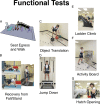Physiological and Functional Alterations after Spaceflight and Bed Rest
- PMID: 29620686
- PMCID: PMC6133205
- DOI: 10.1249/MSS.0000000000001615
Physiological and Functional Alterations after Spaceflight and Bed Rest
Abstract
Introduction: Exposure to microgravity causes alterations in multiple physiological systems, potentially impacting the ability of astronauts to perform critical mission tasks. The goal of this study was to determine the effects of spaceflight on functional task performance and to identify the key physiological factors contributing to their deficits.
Methods: A test battery comprised of seven functional tests and 15 physiological measures was used to investigate the sensorimotor, cardiovascular, and neuromuscular adaptations to spaceflight. Astronauts were tested before and after 6-month spaceflights. Subjects were also tested before and after 70 d of 6° head-down bed rest, a spaceflight analog, to examine the role of axial body unloading on the spaceflight results. These subjects included control and exercise groups to examine the effects of exercise during bed rest.
Results: Spaceflight subjects showed the greatest decrement in performance during functional tasks that required the greatest demand for dynamic control of postural equilibrium which was paralleled by similar decrements in sensorimotor tests that assessed postural and dynamic gait control. Other changes included reduced lower limb muscle performance and increased HR to maintain blood pressure. Exercise performed during bed rest prevented detrimental change in neuromuscular and cardiovascular function; however, both bed rest groups experienced functional and balance deficits similar to spaceflight subjects.
Conclusion: Bed rest data indicate that body support unloading experienced during spaceflight contributes to postflight postural control dysfunction. Further, the bed rest results in the exercise group of subjects confirm that resistance and aerobic exercises performed during spaceflight can play an integral role in maintaining neuromuscular and cardiovascular functions, which can help in reducing decrements in functional performance. These results indicate that a countermeasure to mitigate postflight postural control dysfunction is required to maintain functional performance.
Figures





References
-
- Wood S, Paloski W, Clark J. Assessing sensorimotor function after long-duration spaceflight with computerized dynamic posturography. Aviat Space Env Med. 2015;86(12 Suppl):A45–53. - PubMed
-
- Mulavara AP, Feiveson AH, Fiedler J, et al. Locomotor function after long-duration space flight: effects and motor learning during recovery. Exp Brain Res. 2010;202(3):649–59. - PubMed
-
- Lee SMC, Feiveson AH, Stein S, Stenger MB, Platts SH. Orthostatic intolerance after ISS and space shuttle missions. Aerosp Med Hum Perform. 2015;86(12 Suppl):A54–67. - PubMed
-
- Moore AD, Downs ME, Lee SMC, Feiveson AH, Knudsen P, Ploutz-Snyder L. Peak exercise oxygen uptake during and following long-duration spaceflight. J Appl Physiol (1985). 2014;117(3):231–8. - PubMed
-
- Fitts RH, Riley DR, Widrick JJ. Physiology of a microgravity environment invited review: microgravity and skeletal muscle. J Appl Physiol (1985). 2000;89(2):823–39. - PubMed
Publication types
MeSH terms
Grants and funding
LinkOut - more resources
Full Text Sources
Other Literature Sources

